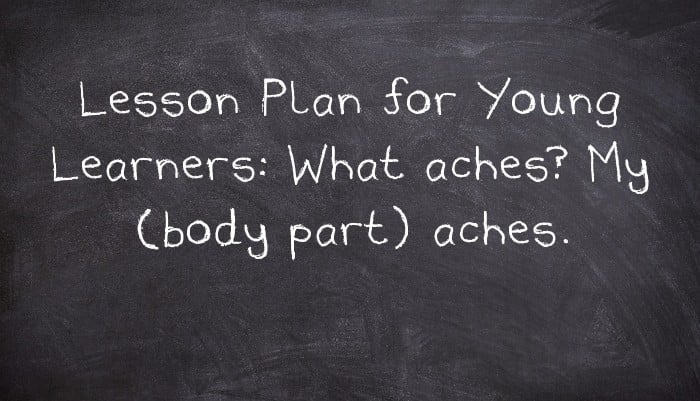Target Language: What aches? My (body part) aches.
Vocabulary: head, eye, ear, nose, mouth, shoulder, knee, toe
Target: Young Learners
Greetings and Warm-up
Greet the class with a good-morning or good-afternoon depending on the day. Have the class stand up and respond to your greeting and do the warm-up. Ask the students, "Do you want to sing a song?" Usually, they'll nod and begin to twitch and move their bodies. Some will respond with a yes.
After the warm-up, sit the students down. Introduce the new vocabulary using flashcards. Show the flashcard or place them on the blackboard. Point to the flashcard and say, head. Have the students repeat after you. Do this a few times for all the new vocabulary.
Model the dialogue with a puppet. I use a Panda puppet to help me do this. Place the flashcards on the blackboard. Take Panda out of a special bag. Say, "Hello Panda" and then introduce him to the class. Ask Panda "What aches?" while pointing to the head flashcard. Panda's answers: "My head aches." Do this for all the flashcards and repeat the question/answer routine a couple of times. Make a mistake or two along the way. Point to the eye flashcard. Have Panda say, "My ear aches." then turn to the students, and have them tell Panda the correct answer.
Divide the class into 2 groups. One group asks the question "What aches?" And the other group answers, "My (body part) aches depending on the flashcard shown. Run between the two groups. Better still, if you have a helper or if the homeroom teacher is present, ask them to help you. Alternate the dialogue between the two groups a few times until they get the hang of the dialogue.
If I there's a Chinese or Japanese teacher or helper in the class, I'll play the "What aches?" game. Divide the class into two equal groups, teams A and B. If there's one team with an extra member, have one student play twice. Line up the two teams in two single straight lines. Demo the game with a few students. Team A students go to Team A teacher and Team B students go to Team B teacher and is asked the question "What aches?" while being shown a flashcard. The respective student responds. They then go to the end of the line and the next student advances. When ready, start the game by shouting out go and encourage the students to advance to the front. Show your student a flashcard and ask him/her "What aches?" S/he answers, "My head aches." Have them go to the end of the line and the next student advances. The first team to get through the questions wins. As a reward, the winning team gets a round of applause.
Activity
Sit the students in a circle. Hold up a flashcard (head), point to it and say, "My head aches." Then hold up a ball and say, "What aches?" Demo with several students. Give the ball to one student and the flashcard to another student. Have them stand up. Get them to practice the dialogue. Do this several times with several different students until the class gets a feel as to what they are suppose to do. If the students are very timid or shy, have two students for each part stand up and do the dialogue. So, two students say, "What aches?" And the other two students say, "My head aches." Play the music and get the students to pass the ball and flashcard around the circle, both going in opposite directions. Stop the music. The two students holding the ball and the flashcard stand up and do the dialogue.
Another game I play is the touching game. The class is divided into two equal teams. Flashcards of body parts are placed on the blackboard. I shout out a flashcard for example, eye, and a member from each team runs to the board to touch it. The first student to touch the flashcard earns a point for their team. The team with the most points wins and receives a round of applause.
Stefan says: A good review for body parts (Stefan says touch your head.) You change Simon to your name to avoid confusing the students with a different name. Tell the students when you say a sentence without the words "Stefan says", for example "Touch your head" then they shouldn't touch their head (body part(s). If a student does, then s/he has to sit out the game. Depending on their comprehension ability, it's best to have the homeroom teacher explain the game in their native tongue to avoid confusion.
Wrap Up
To wrap up the class, I'll teach the song "Head & Shoulders, Knees & Toes" or "Hokey Pokey" or "If you're happy and you know it clap your hands." depending on the language level of the students.
End the class with a good-bye and say, "That's all for today. See you next time."
